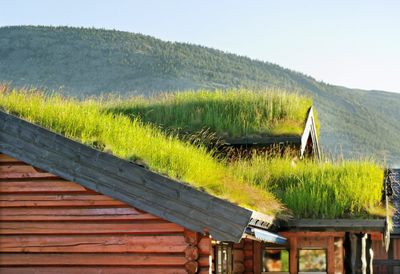What is a Green Roof?
Green roofs, also called vegetative roofs or rooftop gardens, have existed for centuries as an effective way to keep a home warmer in winter and cooler in summer. Sod roofs have been popular since ancient times in places like Iceland and Scandinavia. These days, green roofs are still valued for effectively reducing heat and cooling costs, but also because they can reduce water runoff in areas with high amounts of precipitation, improve air quality in polluted urban settings, create habits for wildlife, increase usable space in the landscape, and help reduce the urban heat island effect. Green roof garden designs are usually one of two types: intensive or extensive.
Intensive green roofs are rooftop gardens where trees, shrubs, and herbaceous plants are grown. Rooftop gardens are oftentimes public spaces, usually have specialized irrigation systems, and may incorporate courtyards, paths, and seating areas. Extensive roof gardens are more like the ancient sod roofs. They are created with shallower soil media and usually filled with herbaceous plants. Extensive green roofs can be done on a very small scale, such as a birdhouse or dog house roof, but they can also be made large enough to cover a home or building’s roof. If you’d like to try creating green roof gardens, you may want to try it out first on a small structure.
Creating Green Roof Gardens
Before starting a DIY green roof garden project, you should hire a structural engineer to make sure the roof can support the weight of a green roof. Also, make sure to get any building permits required by your city or township. Green roofs can be created on flat roofs or a sloped roof; however, it is recommended that you hire a professional to install a green roof if the pitch is more than 30 degrees. Green roof kits can be ordered online. These are generally a system of planting trays that can be attached as needed and ordered in custom sizes. You can also make your own planting box frames with 2 x 6s and 2 x 4s. Green roofs cost approximately $15-50 per square foot (0.1 sq. m.). This can seem expensive at first, but in the long run green roofs save you money on heating and cooling costs. In some cases, grants for green roof projects may be available through the U.S. Environmental Protection Agency. Taking accurate measurements is the first step in creating an extensive green roof. This will help you know what to order if you are ordering a green roof kit. If you plan to build a green roof yourself, measurements will help you know how much pond liner, wood, draining media (gravel), weed barrier, and soil media you will need. Green roofs are a system of layers:
The first layer consists of two layers of pond liner or rubber roofing. The next layer is a drainage layer, such as gravel. Weed barrier is then placed over the gravel layer and a moisture blanket is laid over the weed barrier. More drainage can be added with a layer of wood chips or the final layer of soil medium can be laid. It is suggested that you use a lightweight soilless growing media to keep the overall weight down.
In extensive green roofs, xeriscaping plants are often used. Plants need to have shallow roots and be able to tolerate times of drought and high precipitation, as well as intense heat, high winds, and possible pollution. Good plants for extensive green roofs are:
Succulents Grasses Wildflowers Herbs Mosses Epiphytes
